Classical Civilisation > AS Mark Scheme > GCE Classical Civilisation H408/32: Love and relationships Advanced GCE Mark Scheme for November 202 (All)
GCE Classical Civilisation H408/32: Love and relationships Advanced GCE Mark Scheme for November 2020
Document Content and Description Below
Oxford Cambridge and RSA Examinations GCE Classical Civilisation H408/32: Love and relationships Advanced GCE Mark Scheme for November 2020Oxford Cambridge and RSA Examinations OCR (Oxford Cambr... idge and RSA) is a leading UK awarding body, providing a wide range of qualifications to meet the needs of candidates of all ages and abilities. OCR qualifications include AS/A Levels, Diplomas, GCSEs, Cambridge Nationals, Cambridge Technicals, Functional Skills, Key Skills, Entry Level qualifications, NVQs and vocational qualifications in areas such as IT, business, languages, teaching/training, administration and secretarial skills. It is also responsible for developing new specifications to meet national requirements and the needs of students and teachers. OCR is a not-for-profit organisation; any surplus made is invested back into the establishment to help towards the development of qualifications and support, which keep pace with the changing needs of today’s society. This mark scheme is published as an aid to teachers and students, to indicate the requirements of the examination. It shows the basis on which marks were awarded by examiners. It does not indicate the details of the discussions which took place at an examiners’ meeting before marking commenced. All examiners are instructed that alternative correct answers and unexpected approaches in candidates’ scripts must be given marks that fairly reflect the relevant knowledge and skills demonstrated. Mark schemes should be read in conjunction with the published question papers and the report on the examination. © OCR 2020H408/32 Mark Scheme November 2020 2 Annotations Symbol Description Comment Tick worthy of credit ? unclear S error of spelling E error of grammar, punctuation or expression F error of fact ^ omission H Line to draw an attention to an error H Wavy Line to draw attention to something H Wavy Line to draw attention to something ……… Highlight as directed by PE IRRL irrelevant point REP conspicuous repetitionH408/32 Mark Scheme November 2020 3 L illegible word or phrase BP blank page – this annotation must be used on all blank pages within an answer booklet and on each page of an additional object where there is no candidate response. MARKING INFORMATION Introduction Your first task as an Examiner is to become thoroughly familiar with the material on which the examination depends. You should ensure that you have copies of these materials: • the specification, especially the assessment objectives • the question paper and its rubrics • the mark scheme. You should ensure also that you are familiar with the administrative procedures related to the marking process. These are set out in the OCR booklet Instructions for Examiners. If you are examining for the first time, please read carefully Appendix 5 Introduction to Script Marking: Notes for New Examiners. Please ask for help or guidance whenever you need it. Your first point of contact is your Team Leader. Using the mark scheme Please study this mark scheme carefully. The mark scheme is an integral part of the process that begins with the setting of the question paper and ends with the awarding of grades. Question papers and mark schemes are developed in association with each other so that issues of differentiation and positive achievement can be addressed from the very start. This mark scheme is a working document; it is not exhaustive; it does not provide ‘correct’ answers. The mark scheme can only provide ‘best guesses’ about how the question will work out, and it is subject to revision after we have looked at a wide range of scripts. The Team Leader’ standardisation (SSU) meeting will ensure that the mark scheme covers the range of candidates’ responses to the questions, and that all Examiners understand and apply the mark scheme in the same way. The mark scheme will be discussed and amended at the meeting, and administrative procedures will be confirmed. Please read carefully all the scripts in your allocation and make every effort to look positively for achievement throughout the ability range. Always be prepared to use the full range of marks. Information and instructions for examinersH408/32 Mark Scheme November 2020 4 The practice scripts provide you with examples of the standard of each level. The marks awarded for these scripts will have been agreed by the Team Leaders and will be discussed fully at SSU. The specific task-related indicative content for each question will help you to understand how the level descriptors may be applied. However, this indicative content does not constitute the mark scheme: it is material that candidates might use, grouped according to each assessment objective tested by the question. It is hoped that candidates will respond to questions in a variety of ways. Rigid demands for ‘what must be a good answer’ would lead to a distorted assessment. Candidates’ answers must be relevant to the question. Beware of prepared answers that do not show the candidate’s thought and which have not been adapted to the thrust of the question. Beware also of answers where candidates attempt to reproduce interpretations and concepts that they have been taught but have only partially understood. ASSESSMENT OBJECTIVES Candidates are expected to demonstrate the following in the context of the content described for the individual component: AO1 Demonstrate knowledge and understanding of: • literature, visual/material culture and classical thought • how sources and ideas reflect, and influence, their cultural contexts • possible interpretations of sources, perspectives and ideas by different audiences and individuals. AO2 Critically analyse, interpret and evaluate literature, visual/material culture, and classical thoughts, using evidence to make substantiated judgements and produce coherent and reasoned arguments. Individual questions are designed to allow the distribution of marks between the Assessment Objectives. For some points based marking and the levels of response questions you are required to identify a candidate’s performance under each assessment objective and award marks accordingly. Marking Scripts Answers must be marked using the level descriptors in the marking grids and a mark awarded for each Assessment Objective. The points in the mark scheme are indicative content only and offer some question specific guidance. Credit should be given for other points and different views, if they seem possible and are well argued or supported by good evidence. You must avoid negative marking - don’t deduct marks for individual errors. All marks should be allocated by reference to the assessment grid. Any queries on unexpected answers please consult your Team Leader/Principal Examiner. Using annotations • Take great care to place a tick (see below) against any valid points that lead you to think at all favourably of the answer. • Do not leave any page unmarked (as a last resort tick the very bottom of a page to indicate that you have read it - otherwise Team Leaders/Principal Examiners cannot tell whether account has been taken of that page). • Underline errors and place the appropriate symbol in the margin. • Indicate that you have looked at every page of the answer booklet by placing the BP symbol at the top and bottom of any blank pages.H408/32 Mark Scheme November 2020 5 Ticks: these are the simplest, quickest and most efficient means for examiners to convey approval to Senior Examiners, and they should be inserted where they can be most effective. If the point you wish to highlight is in the middle of a paragraph, then put the tick in the middle of a line in the middle of a paragraph. Overuse of the tick tends to devalue its effectiveness. Do use ticks to draw attention to anything worthy of credit [even single words]. Do not use ticks as a substitute for marking/assessment; marks for questions must be determined by reference to the assessment grid, NOT by mechanical addition of ticks. Highlighting: use highlighting as directed by your Principal Examiner. QUALITY OF EXTENDED RESPONSE • Reasonable but not excessive account should be taken of particularly poor spelling (S), punctuation, and other defects in English grammar and expression (E). • Legibility: use the sign (L) in the margin to areas of a script which you cannot read. • Extreme cases of illegibility should be referred to your Team Leader/Principal Examiner.H408/32 Mark Scheme November 2020 6 Section A Question Indicative Content Marks Guidance 1. Why does Sappho address Aphrodite in line 1 of Source A? Answers may include: • Aphrodite is a goddess (1) of love (1). • Wants help with her beloved (1) / she is lovesick (1) 1 (AO1) All legitimate answers should be credited. 2. Where were Aphrodite’s father’s “golden chambers” (line 8)? • (Mount) Olympus (1). 1 (AO1) All legitimate answers should be credited. 3. Identify one example of Homeric style in Source A and explain how it is used. Answers may include reference to: • Epithet (1) / hymn to a god or goddess (1) / invocation to muses (1) How it is used may include: • Gives us more information about Aphrodite (1). • Makes the poem sound more like a prayer (1) • Dramatic (1) Grand (1) opening to the poem. • Allusions to war 'Be my ally' (1). • Interaction of goddess with mortals c.f Odyssey; kletic hymn, Homeric formula (1). 2 (AO1) All legitimate answers should be credited. Candidates can use bullets to answer the question. 4. Explain how Sappho creates a powerful representation of Aphrodite in Source A? Examples may include: • Interesting epithets which give us a hint about her character. (AO2) o “Aphrodite, goddess of the embroidered throne, Daughter of Zeus, weaver of wiles.”. (AO1) • Aphrodite is clearly powerful/regal status (AO2) o “Queen I beg you”. (AO1) • Aphrodite potentially threatening (AO2) 5 (AO1) 5 (AO2) Use the 10-mark marking grid. AO1 marks are awarded for the selection of material from the source. AO2 marks for the interpretation, analysis and evaluation of this outlined in the Levels of Response grid.H408/32 Mark Scheme November 2020 7 Question Indicative Content Marks Guidance o “Do not overpower my heart…” (AO1) • A strange and beautiful mode of transport/also connected with war (AO2) o “Yoking your chariot: Swift, beautiful sparrows” (AO1) • Aphrodite is a supernatural force (AO2) o “Whirling across the dark earth” (AO1) • A goddess who seems capable of compassion. (AO2) o “Smiling all over your immortal face”. (AO1) • Evidence of a pre-existing relationship between the poet and the goddess. (AO2) o “Whom do you want me to bring back to you this time?” (AO1) o “Who, Sappho, is hurting you now?” (AO1) • Aphrodite’s clear power over love. (AO2) o “…if she does not love you now, she will love you soon”. (AO1) The indicative content is a description of possible content. All legitimate answers and approaches must be credited appropriately. 5. Which ancient civilisation first developed the ideas of Stoicism? • The (Ancient) Greeks (1). 1 (AO1) All legitimate answers should be credited. 6. Explain how far you think Seneca’s society would have agreed with his views on desire. Examples might include: • Marriage was a fundamental part of Roman society (AO2) o Seneca uses his own marriage as a paradigm. (AO1) • Influence of Augustan laws on morality (AO2) o Desire was criminalised (AO1) • Romans would have sexual relationships with slaves and prostitutes. (AO2) o Seneca sees desire as a force to be controlled. (AO1) • Some Romans may have thought Seneca to be hypocritical. (AO2) o Seneca was a tutor to the notoriously dissolute Emperor Nero. (AO1) • Paternity/patriarchy was very important to Romans. (AO2) o Seneca feels that sex between a husband and a wife should be about procreation. (AO1) • Seneca’s description of desire could be hard to understand. (AO2) 5 (AO1) 5 (AO2) Use the 10-mark marking grid. AO1 marks are awarded for the selection of material from the source. AO2 marks for the interpretation, analysis and evaluation of this outlined in the Levels of Response grid. The indicative content is a description of possible content. All legitimate answers and approaches must be credited appropriately.H408/32 Mark Scheme November 2020 8 Question Indicative Content Marks Guidance o Seneca feels that desire is an external force which can be resisted. (AO1) • It is difficult to assess the overall level of agreement with his views (AO2) o Not everyone in Rome had access to education (AO1) • Moderation and frugality were seen as old-fashioned Roman virtues. (AO2) o Seneca compares lust with gluttony; both of which are ruinous to the soul and the body. (AO1) • Seneca gives persuasive descriptions of the power of desire. (AO2) o The destruction of Phaedra. (AO1) • Seneca’s advice on how to cope with desire is useful. (AO2) o Seneca creates a more accommodating type of Stoicism. (AO1) 7. Explain how far Seneca’s views on desire differ from the attitudes expressed in Source A and in the other poems of Sappho which you have read. Justify your response. AO1 Candidates might show knowledge and understanding of: • In Seneca’s tragedy, Phaedra is destroyed by desire. • Sappho prays to Aphrodite to create desire in another • Sappho describes desire as “bitter-sweet” • Seneca compares love to friendship • Sappho gives the names of a few different women in her poems • Seneca mentions his great love for and partnership with his wife • Seneca feels that desire can be controlled and, ultimately, rejected. AO2 Candidates may demonstrate evaluation and analysis through the use of some of the following arguments: • Sappho sees desire as being very important. • Seneca considers desire to be only necessary for procreation. • Sappho sees desire as something to be sought after/celebrated. • Seneca considers desire as a force to be controlled. • Sappho talks about the overwhelming power of desire. • Both consider desire to be potentially ruinous. • Seneca seems to suggest that sex should only be necessary for procreation. 10 (AO1) 10 (AO2) Assess using the marking grids for the 20-mark extended response. The indicative content is a description of possible content only; all legitimate answers and approaches must be credited appropriately. Whilst candidates may use the provided source as a starting point, they should not be penalised if they offer a full and detailed response which does not do so.H408/32 Mark Scheme November 2020 9 Question Indicative Content Marks Guidance • Sappho seems to consider sex to be pleasurable in and of itself.H408/32 Mark Scheme November 2020 10 Section B Question Indicative Content Marks Guidance 8. ‘Sappho shows no understanding of men in her poetry, whereas Ovid shows no understanding of women.’ Assess to what extent you agree with this statement. Support your answer with reference to the sources and ideas which you have studied. AO1 Candidates might show knowledge and understanding of: • Sappho’s wedding poems. • Sappho’s poems which feature male characters. • Sappho’s mention of the relationship between Helen and Paris. • Ovid’s specific knowledge about make-up routines. • Ovid’s advice to women about sex. • Ovid’s advice to women about seeking and winning men. AO2 Candidates may demonstrate evaluation and analysis through the use of some of the following arguments: • Sappho does show some understanding of men in their relationships with women. o Sappho talks about the joy of a bridegroom at his wedding. o Sappho occasionally writes poems which describe relationships between men and women. o Sappho does show that men can have feelings of tenderness. • Ovid presumes women are chiefly concerned with their own vanity. o He describes make-up and hair styles etc. o He writes that women should get ready in secret. o He suggests that sexual positions should be selected on the basis of appearance. • Sappho’s poems come from a woman’s point of view. o She talks about a woman’s fear of losing her virginity. o The wedding night is also something to be feared for a woman. o Marriage is seen as an end rather than a beginning. 10 (AO1) 20 (AO2) Assess using the marking grids for the 30-mark extended response. The indicative content is a description of possible content only; all legitimate answers and approaches must be credited appropriately. Learners are expected to make use of scholarly views, academic approaches and sources to support their argument; the approach to crediting this is outlined in the Levels of Response Grid.H408/32 Mark Scheme November 2020 11 Question Indicative Content Marks Guidance • Ovid shows no appreciation of the vulnerability of women in Roman society. o He seems to presume that women had more freedom than they did. o He could even be seen to be mocking women’s lack of agency. o Ovid is writing as a man who purports to understand women. o Although he does acknowledge that there are different expectations for different women. • Ovid does give some good advice. o He does attempt to give confidence to women. o He offers plenty of positive suggestions. o Ovid’s conceit that he is providing women with secret knowledge in the war of love. 9. Assess to what extent you feel that Seneca would have agreed with Plato’s definitions of love. Support your answer with reference to the sources and ideas which you have studied. AO1 Candidates might show knowledge and understanding of: • Plato’s various definitions of love in Symposium. • Seneca description of love as “a kind of friendship”. • Plato’s descriptions of relationships in works other than Symposium. • Plato’s descriptions of the dangers of love in society. • Seneca talks about the dangers of too much love exposing men to ridicule. AO2 Candidates may demonstrate evaluation and analysis through the use of some of the following arguments: • Plato is not a Stoic. o He does not feel that love and desire should be resisted but rather feels that moderation is key. o He describes love as an internal feeling rather than an external force. • Plato sees love as necessary. o Love can be very positive in gaining wisdom and ascending to a higher 10 (AO1) 20 (AO2) Assess using the marking grids for the 30-mark extended response. The indicative content is a description of possible content only; all legitimate answers and approaches must be credited appropriately. Learners are expected to make use of scholarly views, academic approaches and sources to support their argument; the approach to crediting this is outlined in the Levels of Response Grid.H408/32 Mark Scheme November 2020 12 Question Indicative Content Marks Guidance understanding of beauty. o He describes love as the search for one’s other half. • Plato describes love in a variety of relationships. o In Symposium, he focuses on homoerotic relationships. o He suggests that homoerotic relationships might be more worthy. • Seneca only describes love in marriage. o He focuses on the partnership between himself and his wife. o Love which does not result in procreation is eschewed. • Plato gives a variety of definitions of love. o Many are very complicated and involved. • Seneca only describes love in marriage. o He focuses on the partnership between himself and his wife. o Love which does not result in procreation is eschewed. o His comparison between love and friendship is simple and easy to understand.H408/32 Mark Scheme November 2020 13 Guidance on applying the marking grids for the 10-mark stimulus question Two Assessment Objectives are being assessed in this question: AO1 and AO2. The two Assessment Objectives are equally weighted. Examiners must use a best fit approach to the marking grid. Where there are both strengths and weaknesses in a particular response, particularly imbalanced responses in terms of the assessment objectives, examiners should carefully consider which level is the best fit for the performance overall. For example, you should not be able to achieve a mark of 8 made up of AO1 = 6 and AO2 = 2. When using this grid: • Determine the level: start at the highest level and work down until you reach the level that matches the answer • Determine the mark within the level: consider whether the response consistently meets the criteria for the level, and/or could be described as closer to the level above or the one below. • Marks for questions must be determined by reference to the assessment grid, NOT by mechanical addition of ticks. Level Marks Characteristics of Performance 5 9–10 AO1: Shows very good knowledge and understanding of the provided source/ideas through a range of well selected, accurate and precise material from it AO2: Fully and consistently engages with the question, with perceptive, critical analysis and interpretation of the provided source leading to convincing points which are well-supported and developed 4 7–8 AO1: Shows good knowledge and understanding of the provided source/ideas through a range of well selected, mostly accurate, material from it AO2: Engages clearly and directly with the question, with critical analysis and interpretation of the provided source leading to sound points, which are supported and developed 3 5–6 AO1: Shows reasonable knowledge and understanding of the provided source/ideas through use of a range of mostly accurate material from it AO2: Engages with some of the fundamental issues of the question, with analysis and interpretation of the provided source leading to some tenable points, which have some support and development 2 3–4 AO1: Shows basic knowledge and understanding of the provided source/ideas through use of some material from it with some degree of accuracy AO2: Engages with the general topic of the question, with little analysis and interpretation of the provided source leading to weak points, which have occasional support and development 1 1–2 AO1: Shows limited knowledge and understanding of the provided source/ideas through little use of accurate material from it AO2: Limited and very simplistic attempt to engage with the topic of the question, with very little analysis and interpretation of the provided source leading to points of little relevance 0 0 No response or no response worthy of creditH408/32 Mark Scheme November 2020 14 Guidance on applying the marking grids for the 20-mark extended response Two Assessment Objectives are being assessed in this question: AO1 and AO2.The two Assessment Objectives are equally weighted. Examiners must use a best fit approach to the marking grid. Where there are both strengths and weaknesses in a particular response examiners should carefully consider which level is the best fit for the performance overall. Note that candidates can achieve different levels in each assessment objective, for example a Level 3 for AO1, and a Level 2 for AO2. When using this grid: • Determine the level: start at the highest level and work down until you reach the level that matches the answer • Determine the mark within the level: consider whether the response consistently meets the criteria for the level, and/or could be described as closer to the level above or the one below • Marks for questions must be determined by reference to the assessment grid, NOT by mechanical addition of ticks. AO1 AO2 Level Marks Characteristics of Performance Level Marks Characteristics of Performance 5 9 – 10 • very detailed knowledge and a thorough understanding of the material studied • use of a range of well selected, accurate and precise material from classical sources and appropriate, effective use of their cultural context and possible interpretation 5 9 – 10 • a very good response to the question containing a wide range of relevant points leading to convincing conclusions • points are very well supported by perceptive critical analysis, interpretation and evaluation of classical sources and/or classical ideas The response is logically structured, with a well-developed, sustained and coherent line of reasoning 4 7 – 8 • detailed knowledge and a sound understanding of the material studied • use of a range of well selected, mostly accurate, material from classical sources and appropriate use of their cultural context and possible interpretation 4 7 – 8 • a good response to the question containing a range of relevant points leading to appropriate conclusions • points are consistently supported by critical analysis, interpretation and evaluation of classical sources and/or classical ideas the response is logically structured, with a well-developed and clear line of reasoning 3 5 – 6 • reasonable knowledge and understanding of the material studied • use of a range of mostly accurate material from classical sources and some use of their cultural context and possible interpretation 3 5 – 6 • a reasonable response to the question containing some relevant points leading to tenable conclusions • points are generally supported by analysis, interpretation and evaluation of classical sources and/or classical ideas the response presents a line of reasoning which is mostly relevant and has some structure 2 3 – 4 • basic knowledge and understanding of the material studied • use of a limited range of material from classical sources with some degree of accuracy, and limited use of their cultural context and possible interpretation 2 3 – 4 • a basic response to the question containing some points, which may be narrow in scope and limited in relevancy, leading to weak conclusions • points are occasionally supported by analysis, interpretation and evaluation of classical sources and/or classical ideas the response presents a line of reasoning but may lack structure 1 1 – 2 • limited knowledge and understanding of the material studied • use of little accurate material from classical sources and little or no use of their cultural context and possible interpretation 1 1 – 2 • little engagement with the question, any points or conclusions made are of little relevance • isolated use of classical sources and/or classical ideas with little analysis, interpretation and evaluation the information is communicated in an unstructured way 0 0 • no response or no response worthy of credit 0 0 • no response or no response worthy of creditH408/32 Mark Scheme November 2020 15 Guidance on applying the marking grids for the 30-mark extended response Two Assessment Objectives are being assessed in this question: AO1 and AO2.The two Assessment Objectives are equally weighted. Examiners must use a best fit approach to the marking grid. Where there are both strengths and weaknesses in a particular response examiners should carefully consider which level is the best fit for the performance overall. Note that candidates can achieve different levels in each assessment objective, for example a Level 3 for AO1, and a Level 2 for AO2. When using this grid: • Determine the level: start at the highest level and work down until you reach the level that matches the answer • Determine the mark within the level: consider whether the response consistently meets the criteria for the level, and/or could be described as closer to the level above or the one below • Marks for questions must be determined by reference to the assessment grid, NOT by mechanical addition of ticks. AO1 AO2 Level Marks Characteristics of Performance Level Marks Characteristics of Performance 5 9 – 10 • very detailed knowledge and a thorough understanding of the material studied • use of a range of well selected, accurate and precise material from classical sources and appropriate, effective use of their cultural context and possible interpretation 5 17 – 20 • a very good response to the question containing a wide range of relevant points leading to convincing conclusions • points are very well supported by critical perceptive analysis, interpretation and evaluation of classical sources and/or classical ideas and secondary sources, scholars and/or academic works the response is logically structured, with a well-developed, sustained and coherent line of reasoning 4 7 – 8 • detailed knowledge and a sound understanding of the material studied • use of a range of well selected, mostly accurate, material from classical sources and appropriate use of their cultural context and possible interpretation 4 13 – 16 • a good response to the question containing a range of relevant points leading to appropriate conclusions • points are consistently supported by critical analysis, interpretation and evaluation of classical sources and/or classical ideas and secondary sources, scholars and/or academic works the response is logically structured, with a well-developed and clear line of reasoning 3 5 – 6 • reasonable knowledge and understanding of the material studied • use of a range of mostly accurate material from classical sources and some use of their cultural context and possible interpretation 3 9 – 12 • a reasonable response to the question containing some relevant points leading to tenable conclusions • points are generally supported by analysis, interpretation and evaluation of classical sources and/or classical ideas and there is some use of secondary sources scholars and/or academic works the response presents a line of reasoning which is mostly relevant and has some structure 2 3 – 4 • basic knowledge and understanding of the material studied • use of a limited range of material from classical sources with some degree of accuracy, and limited use of their cultural context and possible interpretation 2 5 – 8 • a basic response to the question containing some points, which may be narrow in scope and limited in relevancy, leading to weak conclusions • points are occasionally supported by analysis, interpretation and evaluation of classical sources and/or classical ideas and there is little or no use of secondary sources, scholars and/or academic works the response presents a line of reasoning but may lack structure 1 1 – 2 • limited knowledge and understanding of the material studied • use of little accurate material from classical sources and little or no use of their cultural context and possible interpretation 1 1 – 4 • little engagement with the question and any points or conclusions made are of little or no relevance • isolated use of classical sources and/or classical ideas with little analysis, interpretation and evaluation the information is communicated in an unstructured way 0 0 • no response or no response worthy of credit 0 0 • no response or no response worthy of creditOCR (Oxford Cambridge and RSA Examinations) The Triangle Building Shaftesbury Road Cambridge CB2 8EA [Show More]
Last updated: 1 year ago
Preview 1 out of 17 pages

Reviews( 0 )
Document information
Connected school, study & course
About the document
Uploaded On
Oct 10, 2022
Number of pages
17
Written in
Additional information
This document has been written for:
Uploaded
Oct 10, 2022
Downloads
0
Views
55








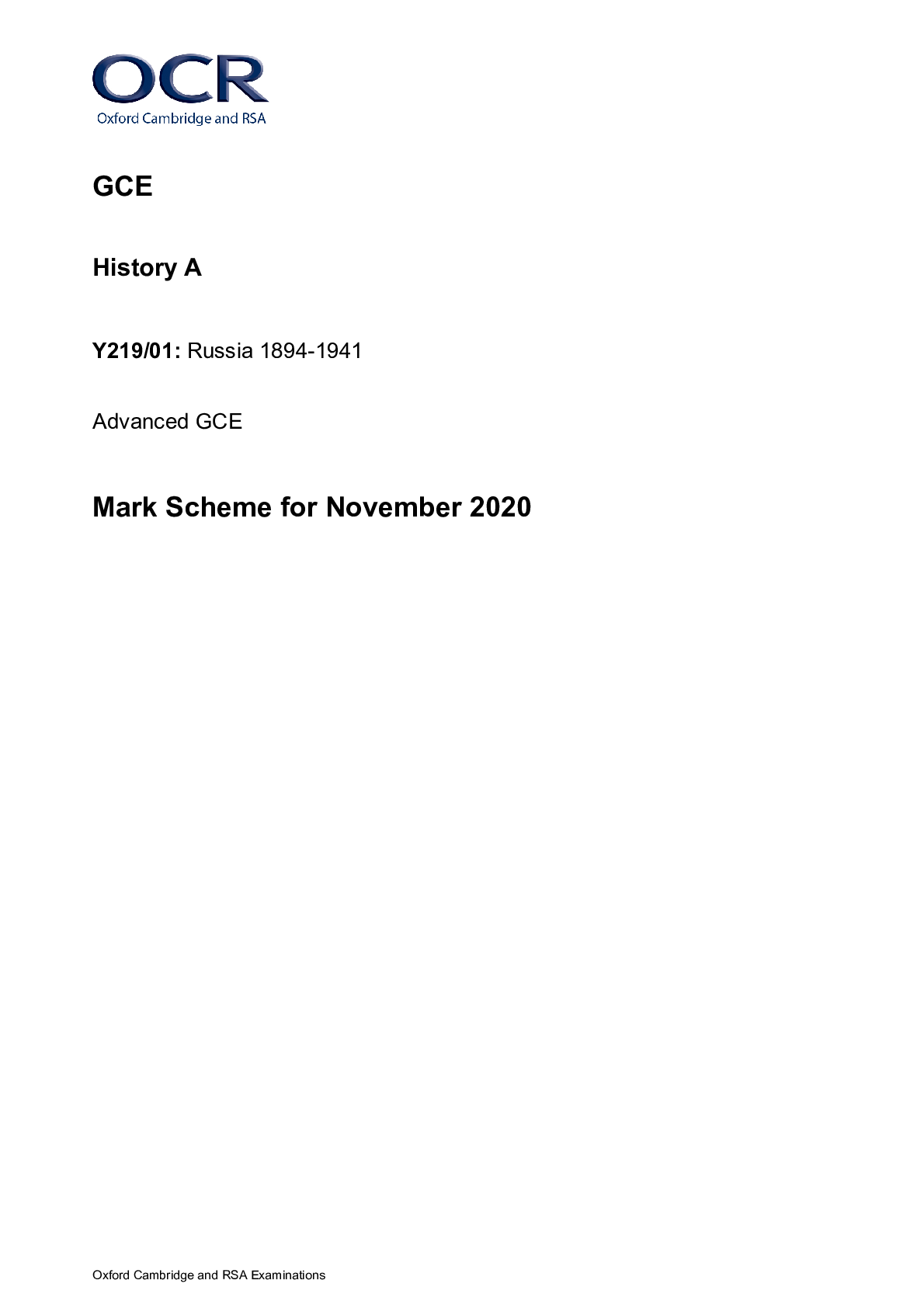
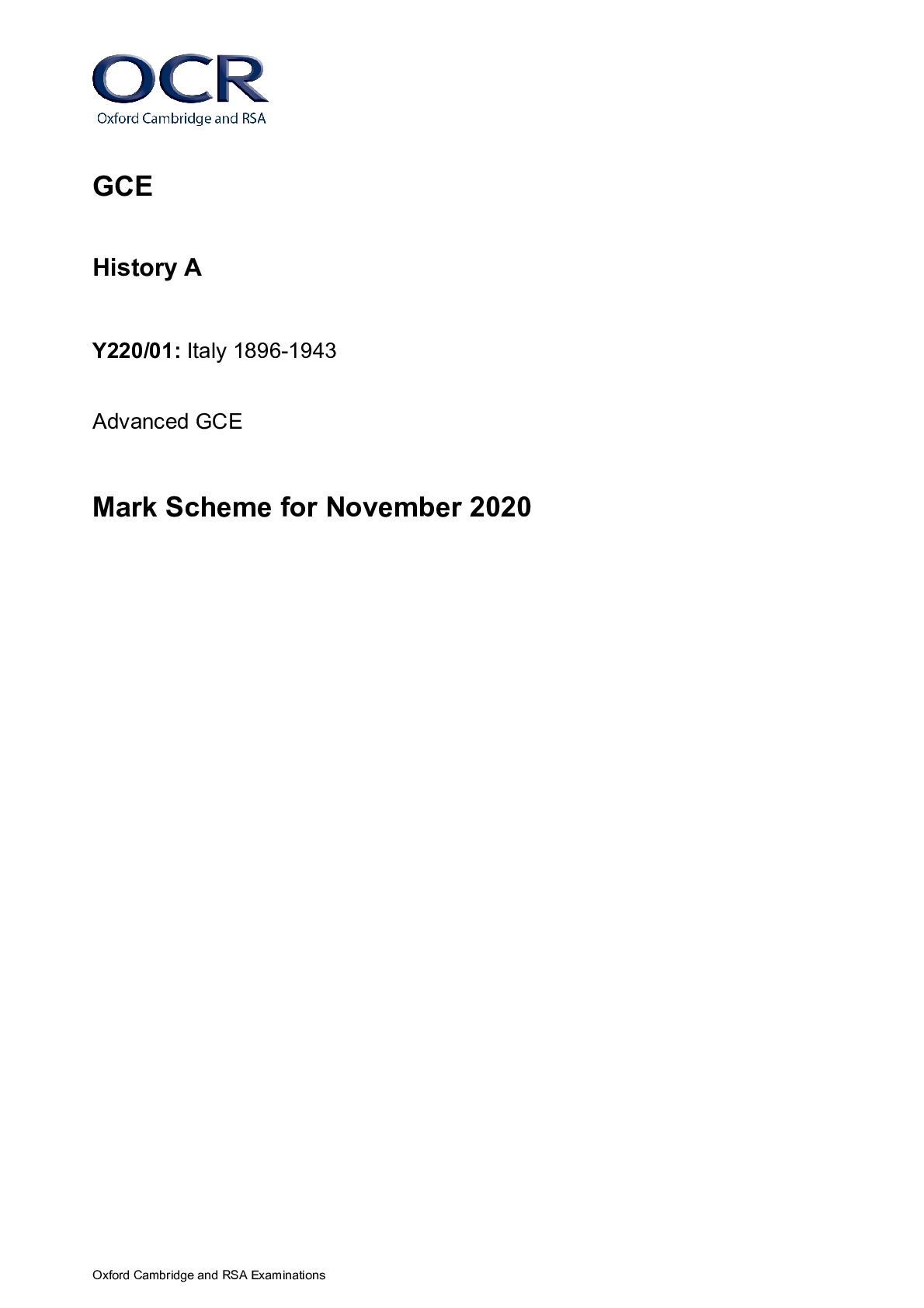

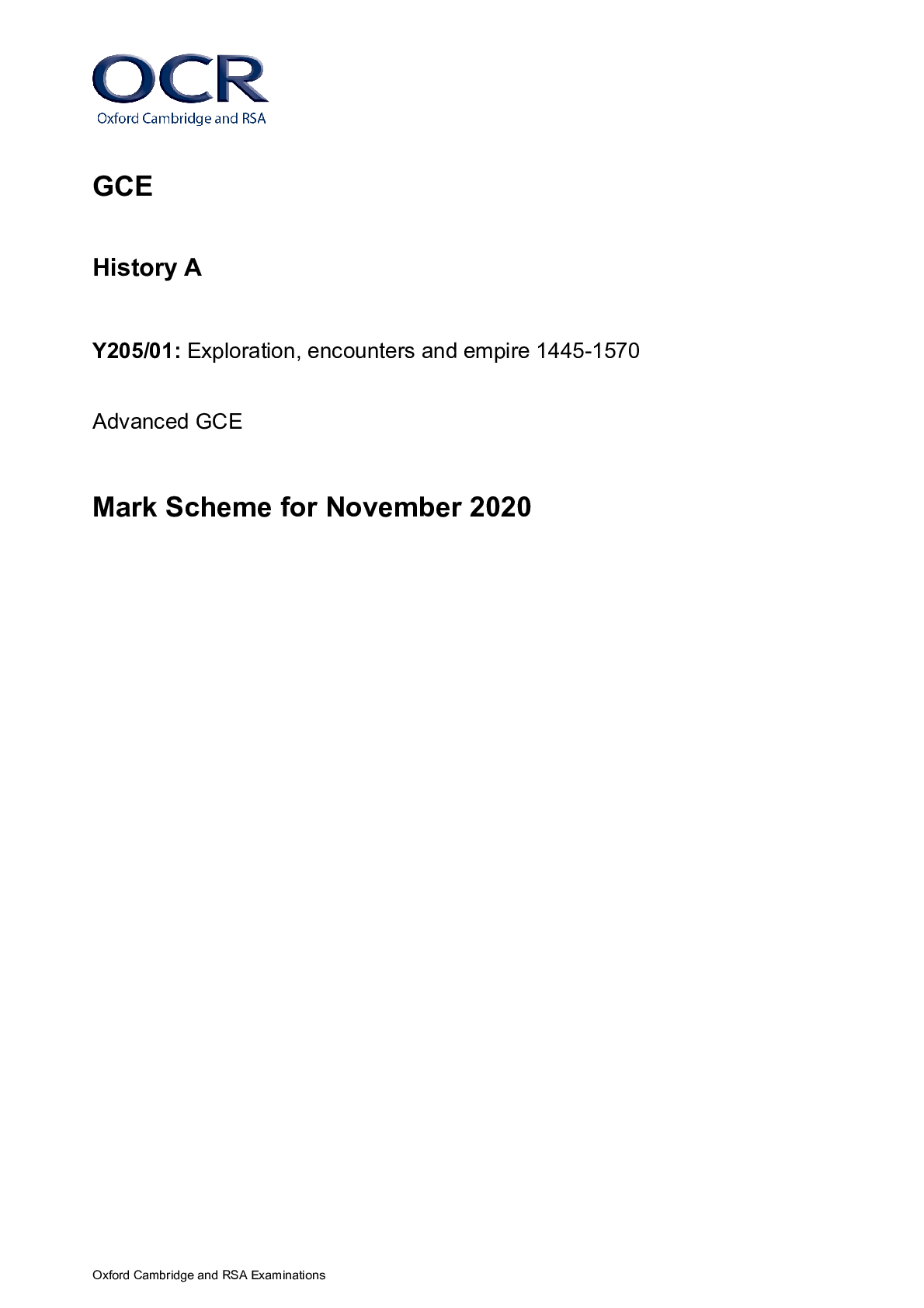
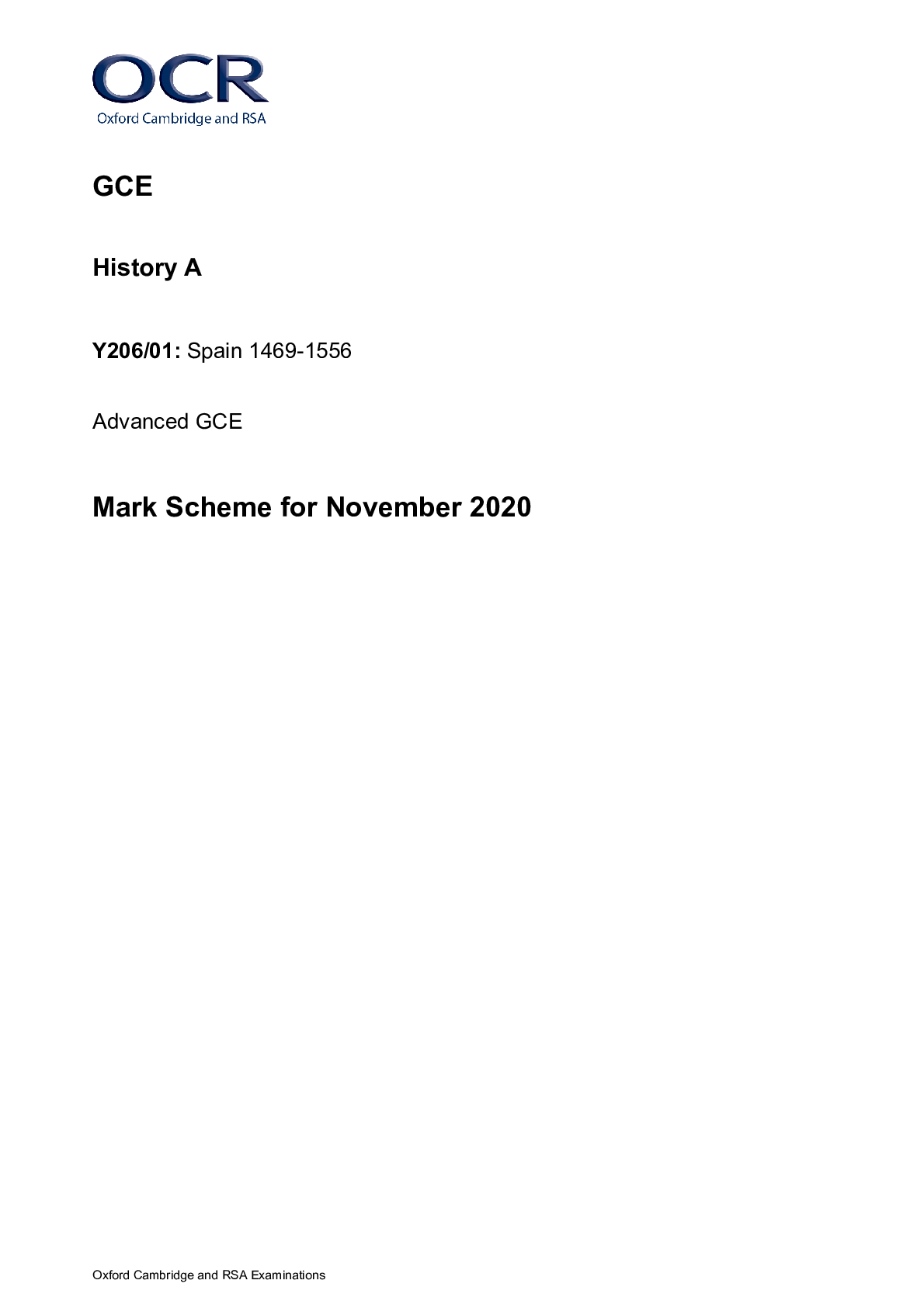
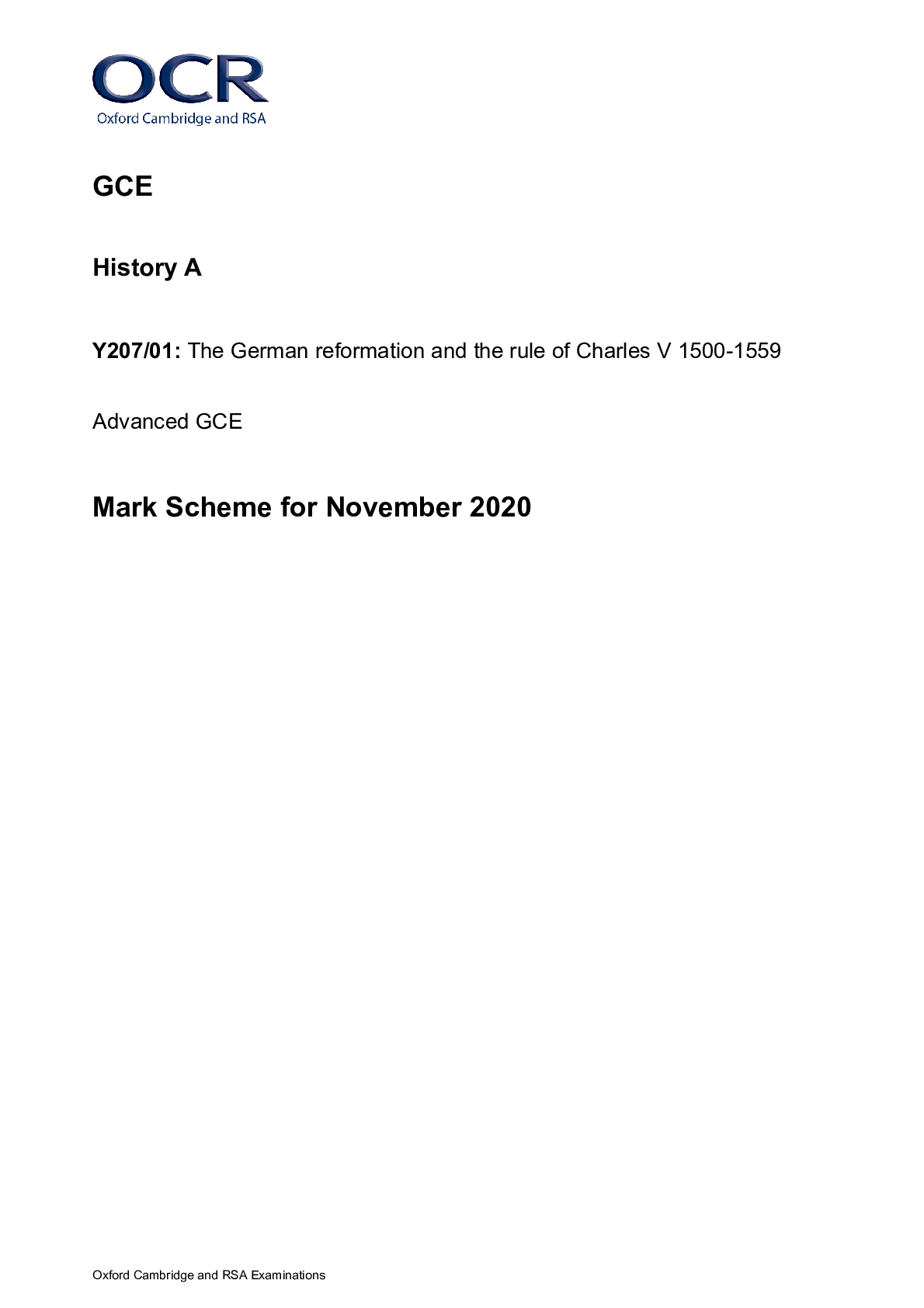
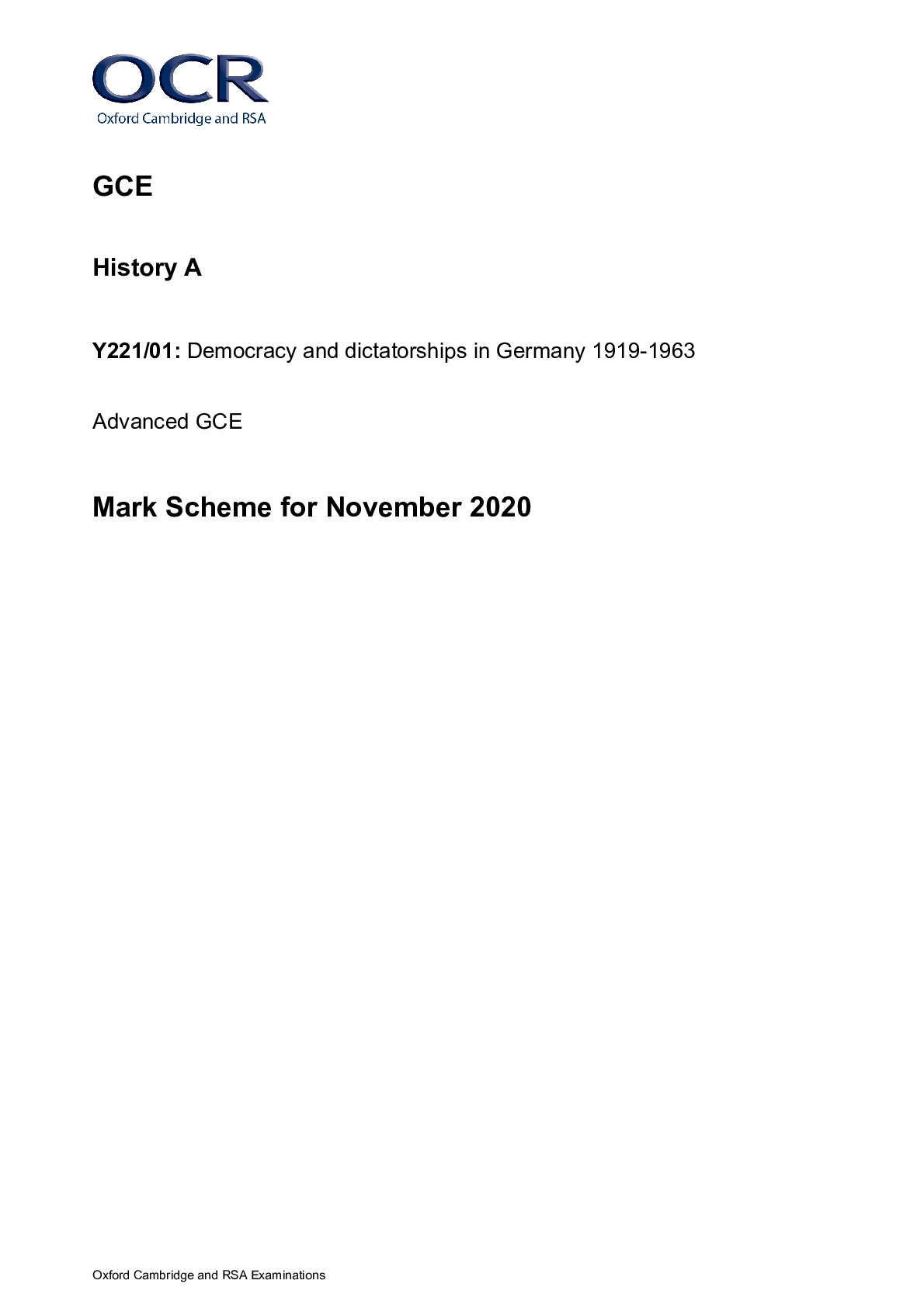

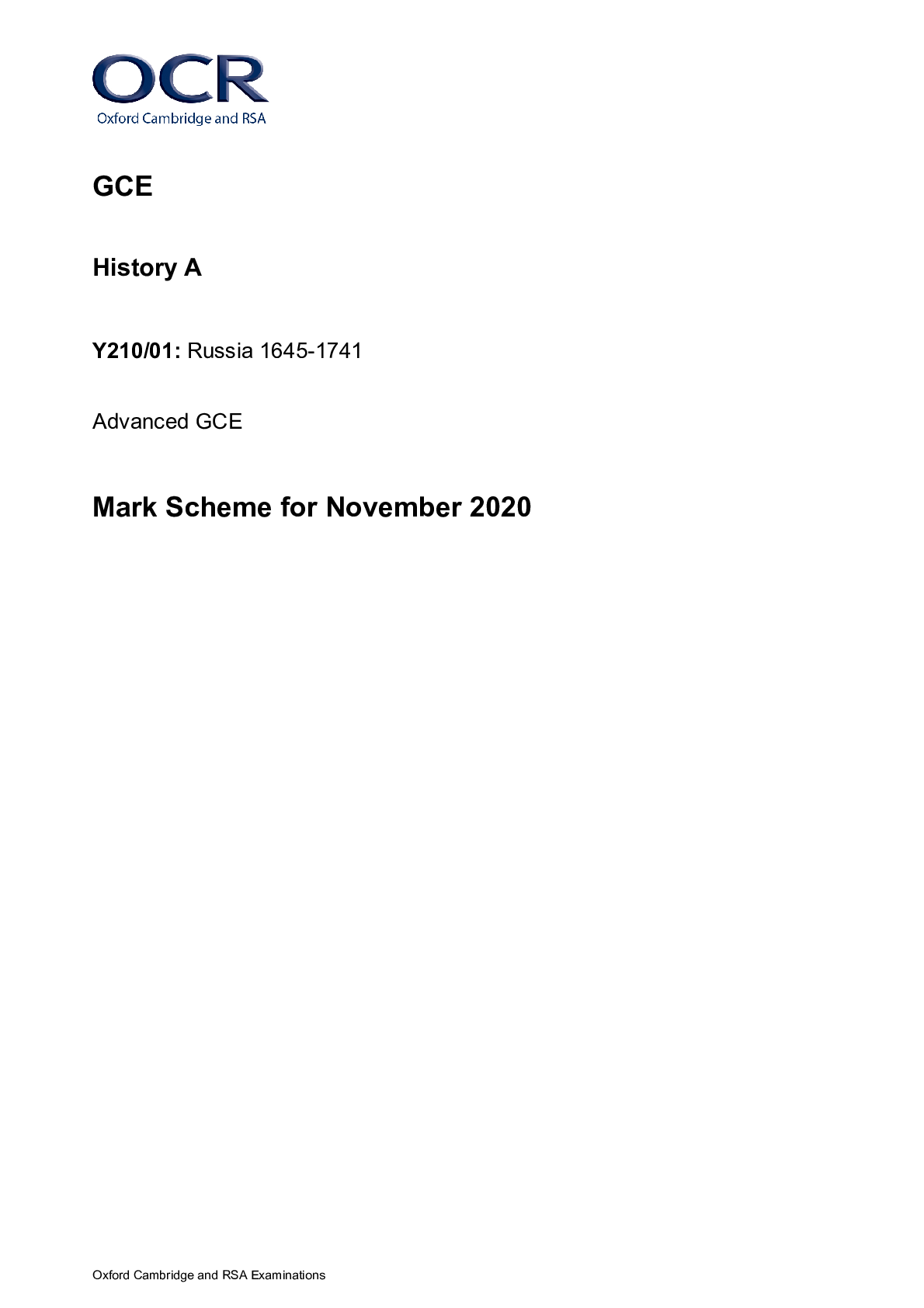


.png)






